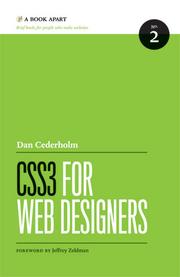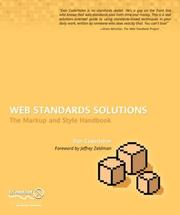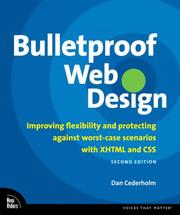| Listing 1 - 9 of 9 |
Sort by
|

ISBN: 9780984442522 Year: 2010 Volume: 2 Publisher: New York : A book apart,
Abstract | Keywords | Export | Availability | Bookmark
 Loading...
Loading...Choose an application
- Reference Manager
- EndNote
- RefWorks (Direct export to RefWorks)
From advanced selectors to generated content to the triumphant return of web fonts, and from gradients, shadows, and rounded corners to full-blown animations, CSS3 is a universe of creative possibilities. No one can better guide you through these galaxies than world-renowned designer, author, and CSS superstar Dan Cederholm. Learn what works, how it works, and how to work around browsers where it doesn't work.
webdesign --- computer animation --- Computer. Automation --- CSS (cascading style sheets)
Book
ISBN: 1430219203 9786612510571 1282510576 1430219211 9781282510579 9781430219217 Year: 2009 Publisher: Berkeley, CA : New York : Friendsof Ed/Apress ; Distributed by Springer-Verlag New York,
Abstract | Keywords | Export | Availability | Bookmark
 Loading...
Loading...Choose an application
- Reference Manager
- EndNote
- RefWorks (Direct export to RefWorks)
Welcome to the expanded second edition of Dan Cederholm's bestselling Web Standards Solutions. Web standards are the standard technology specifications enforced by the World Wide Web Consortium (W3C) to make sure that web designers and browser manufacturers are using the same technology syntax. It is important that these implementations are the same throughout the Web—otherwise, it becomes a messy proprietary place, and lacks consistency. These standards also allow content to be more compatible with multiple different viewing devices, such as screen readers for people with vision impairments, cell phones, PDFs, etc. HTML, XML, and CSS are all such technologies. This book is your essential guide to understanding the advantages you can bring to your web pages by implementing web standards and precisely how to apply them. Web standards such as XHTML and CSS are now fairly well-known technologies, and they will likely be familiar to you, the web designer. Indeed, they are all around you on the Web. However, within web standards still lies a challenge: while the browser's support for web standards is steadily increasing, many web developers and designers have yet to discover the real benefits of web standards and respect the need to adhere to them. The real art is in truly understanding the benefits and implementing the standards efficiently. As a simple example of its power, you can use CSS to lay out your pages instead of nesting tables. This can make file sizes smaller, allowing pages to load faster, ultimately increasing accessibility for all browsers, devices, and web users. Expanded edition containing bonus material. Teaches how to use Web standards effectively to build better web sites. Solutions style promotes learning by work-through examples and assessments.
Cascading style sheets. --- HTML (Document markup language). --- Web sites -- Design -- Standards. --- XHTML (Document markup language). --- Engineering & Applied Sciences --- Electrical & Computer Engineering --- Computer Science --- Telecommunications --- Information Technology --- Computer Science (Hardware & Networks) --- HTML (Document markup language) --- Web sites --- XHTML (Document markup language) --- Design --- Standards. --- eXtensible HyperText Markup Language (Document markup language) --- Pages, Web --- Sites, Web --- Web pages --- Websites --- World Wide Web pages --- World Wide Web sites --- WWW pages --- WWW sites --- HyperText Markup Language (Document markup language) --- CSS (Document markup language) --- Style sheets, Cascading --- Computer science. --- Computer Science. --- Computer Science, general. --- Document markup languages --- Computer network resources --- Computer programming. --- Software engineering. --- Web Development. --- Software Engineering/Programming and Operating Systems. --- Computer software engineering --- Engineering --- Computers --- Electronic computer programming --- Electronic data processing --- Electronic digital computers --- Programming (Electronic computers) --- Coding theory --- Programming

ISBN: 9781590593813 Year: 2004 Publisher: New York : Springer Verlag,
Abstract | Keywords | Export | Availability | Bookmark
 Loading...
Loading...Choose an application
- Reference Manager
- EndNote
- RefWorks (Direct export to RefWorks)
Digital
ISBN: 9781430219217 Year: 2009 Publisher: Berkeley, CA Apress
Abstract | Keywords | Export | Availability | Bookmark
 Loading...
Loading...Choose an application
- Reference Manager
- EndNote
- RefWorks (Direct export to RefWorks)

ISBN: 0321509021 9780321509024 Year: 2008 Publisher: Berkeley New Riders
Abstract | Keywords | Export | Availability | Bookmark
 Loading...
Loading...Choose an application
- Reference Manager
- EndNote
- RefWorks (Direct export to RefWorks)
Cascading style sheets --- Web site development --- XHTML (Document markup language)
Book
ISBN: 9781937557126 Year: 2016 Publisher: New York A book apart
Abstract | Keywords | Export | Availability | Bookmark
 Loading...
Loading...Choose an application
- Reference Manager
- EndNote
- RefWorks (Direct export to RefWorks)
Book
ISBN: 1430210893 Year: 2004 Publisher: New York, New York : Apress Media LLC,
Abstract | Keywords | Export | Availability | Bookmark
 Loading...
Loading...Choose an application
- Reference Manager
- EndNote
- RefWorks (Direct export to RefWorks)
Web standards are the standard technology specifications enforced by the World Wide Web Consortium (W3C) to make sure that web designers and browser manufacturers are using the same technology syntax. It is important that these implementations are the same throughout the Web, otherwise it becomes a messy proprietary place, and lacks consistency. These standards also allow content to be more compatible with multiple different viewing devices, such as screen readers for people with vision impairments, cell phones, PDFs, etc. HTML, XML, and CSS are all such technologies. This book is your essential guide to understanding the advantages you can bring to your web pages by implementing web standards and precisely how to apply them. Web standards such as XHTML and CSS are now fairly well-known technologies, and they will likely be familiar to you, the web designerindeed, they are all around you on the Web. However, within web standards still lies a challengewhile the browser's support for web standards is steadily increasing, many web developers and designers have yet to discover the real benefits of web standards and respect the need to adhere to them. The real art is in truly understanding the benefits and implementing the standards efficiently. As a simple example of its power, you can use CSS to lay out your pages instead of nesting tables. This can make file sizes smaller, allowing pages to load faster, ultimately increasing accessibility for all browsers, devices, and web users. Use XHTML elements correctly so that your markup is compact and more easily understood. Use CSS to style different elements of a web page. Lay out pages easily and effectively. Compare multiple methods of achieving the same results to make better design choices. Learn about advanced web design techniques and their important caveats. Web Standards Solutions is broken down into 16 short chapters, each covering the theory and practice of different web standards concept and showing multiple solutions to given problems for easy learning. You'll learn about multi-column layouts, using image replacement techniques to your best advantage, making the best use of tables and lists, and many more. This highly modular approach allows you to rapidly digest, understand, and utilize the essentials of web standards.
Book
ISBN: 9781430219217 Year: 2009 Publisher: Berkeley CA Apress
Abstract | Keywords | Export | Availability | Bookmark
 Loading...
Loading...Choose an application
- Reference Manager
- EndNote
- RefWorks (Direct export to RefWorks)
You hold in your hands a recipe book. With clear examples and no wasted words, designer Dan Cederholm shows how to put web standards to work creating beautiful, lightweight interfaces that are accessible to all. Dan isn't here to make the creative or business case for standards-based web design. Others (cough) have already done that. And frankly, if you've bothered to pick up this book and thumb through its pages, you probably already know the accessibility, longevity, and business benefits standards-based design provides. You don't need another overview or elevator pitch; you need a practical, roll-up-your-sleeves, component view, and that's what this book delivers. In down-to-earth, natural language the same kind of language that's found on good websites Dan examines universal site elements such as page divisions and navigation. Using a teaching method he pioneered at SimpleBits.com, Dan shows how web standards make these universal page components easier to create, easier to modify when your boss or client requests la- minute changes, and most important of all, easier for people to use.
Book
ISBN: 9782212117653 2212117655 Year: 2016 Publisher: Paris: Eyrolles,
Abstract | Keywords | Export | Availability | Bookmark
 Loading...
Loading...Choose an application
- Reference Manager
- EndNote
- RefWorks (Direct export to RefWorks)
Les CSS sont aujourd'hui un incontournable pour tous les web designers ; des sélecteurs avancés à la génération de contenu, en passant par les web fonts, les dégradés, les ombres et les arrondis, jusqu'aux animations les plus complètes, CSS3 offre tout un univers de possibilités créatrices. Nul ne pouvait mieux vous guider à travers ces galaxies que le web designer de renom, auteur et superstar des CSS, Dan Cederholm, qui dans cette nouvelle édition mise à jour, vous présente de nouvelles propriétés et techniques, avec notamment un tout nouveau chapitre sur les mises en page à petite échelle (agencement en multicolonnes, Flexbox). Découvrez avec lui ce qui marche, comment ça marche et que faire quand ça ne marche pas !
| Listing 1 - 9 of 9 |
Sort by
|

 Search
Search Feedback
Feedback About UniCat
About UniCat  Help
Help News
News